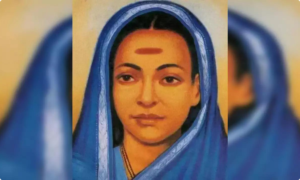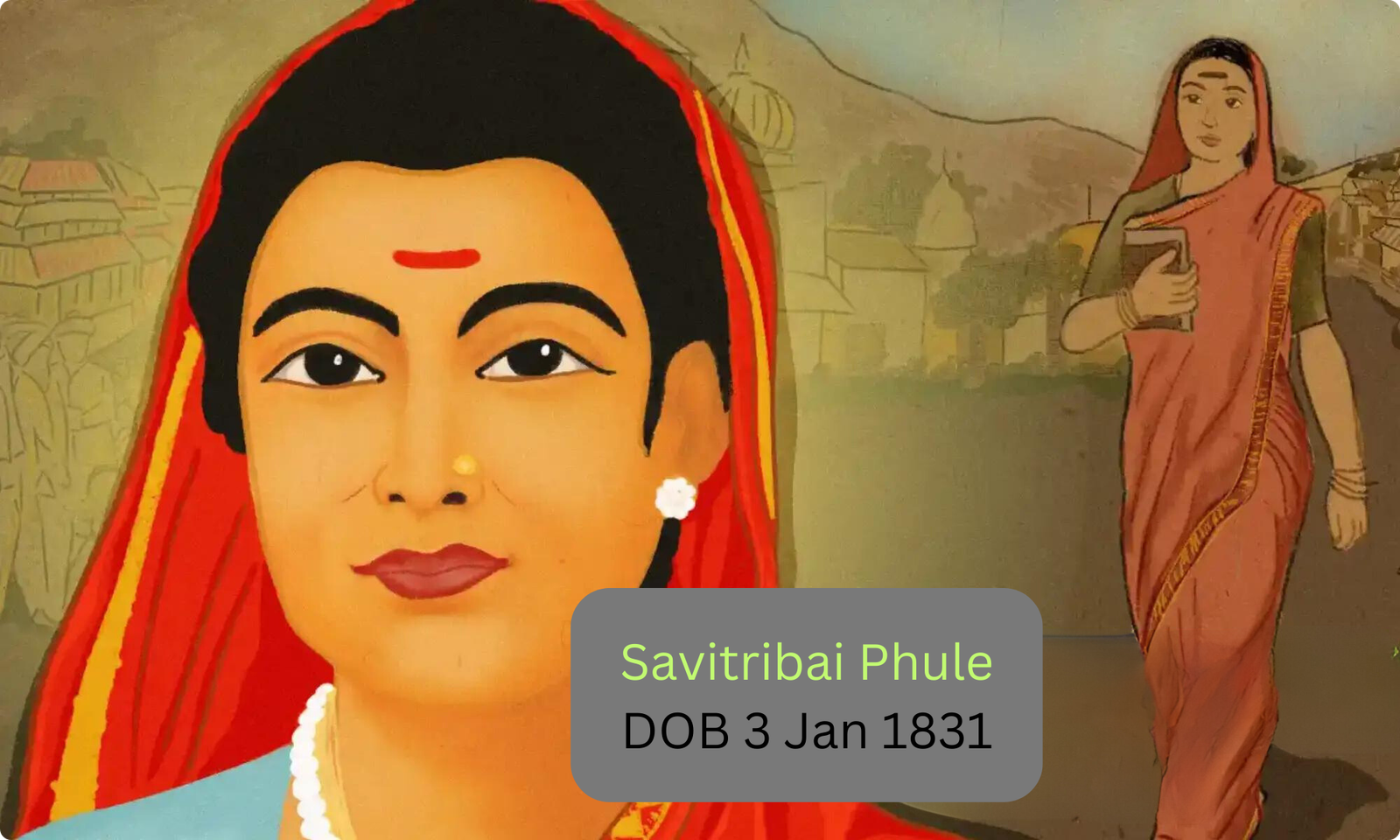Savitribai Phule was a well-known Indian social reformer, poet, and educationist who was crucial to the nineteenth-century empowerment and education of women. Along with her husband Jyotirao Phule, Savitribai, one of the few educated women of the era, is credited with starting the first school for girls in Pune at Bhide Wada. She worked very hard to educate and free child widows, advocated for widow remarriage, and fought against sati pratha and child marriage.
On the occasion of her 193rd birthday, a review of the life of Savitribai Phule, the first female teacher in India.
Savitribai Phule Ji always raised her voice strongly for the education of women and the underprivileged. #MannKiBaat pic.twitter.com/sxmIC1XbWL
— PMO India (@PMOIndia) December 31, 2023
Along with individuals like B. R. Ambedkar and Annabhau Sathe, she is regarded as an icon of the Dalit Mang caste and was a key player in Maharashtra’s social reform movement. She actively participated in the fight to end caste and gender-based discrimination and ran a campaign against untouchability.
Early Life of Savitribai Phule
Born into a farming family, Savitribai was the eldest daughter of Khandoji Neveshe Patil and Lakshmi. Her parents were from Naigaon, which is now in the Satara district of British India. In 1840, nine-year-old Savitribai married 12-year-old Jyotirao Phule, according to the custom of marrying off girls at an early age.
Jyotirao went on to become an anti-caste social reformer, writer, activist, and thinker. He is regarded as one of the main players in the social reform movement in Maharashtra. After her marriage, Savitribai began her education. Her spouse was the one to teach her how to read and write after noticing her desire to become well-informed. After passing a normal school’s third and fourth year exams, she developed a strong passion for teaching She obtained education at Ahmednagar’s Ms. Farar’s Institution. Savitribai had Jyotirao’ s constant backing in all of her social activities.
Role in Women’s Empowerment & Education
While Savitribai was still in her teens, Jyotirao and her created the first school for girls in Pune (then known as Poona) in 1848. Despite facing rejection from their family and community, the unchanging couple found refuge with their friend Usman Sheikh and his sister Fatima Sheikh. These individuals also provided the Phule couple with a space on their property to establish the school. Savitribai was the school’s first teacher. Later, Jyotirao and Savitribai established schools for kids from the castes known as untouchables, the Mang and Mahar.
In 1852 there were three Phule schools open for the education. The Phule family was recognized by the British government on November 16th, that year, for their contributions to education, and Savitribai was named the best teacher. She also founded the Mahila Seva Mandal in that year with the intention of educating women about their rights, dignity, and other social issues. She was successful in calling for a barbers’ strike in Pune and Mumbai to protest the common custom of shaving widows’ heads.
Savitribai Phule, 1854
It’s one of many poems that Phule wrote to inspire the oppressed to become educated and end oppression based on caste.
“Be self-reliant, be industrious
Work, gather wisdom and riches,
All gets lost without knowledge
We become animal without wisdom,
Sit idle no more, go, get education
End misery of the oppressed and forsaken,
You’ve got a golden chance to learn
So learn and break the chains of caste.
Throw away the Brahman’s scriptures fast.”
By 1858, all three of the Phule’s’ schools had closed. This was caused by a number of factors, such as the government’s withdrawal of support, an end of private European donations following the Indian Rebellion of 1857, and Jyotirao’ s resignation from the school management committee over disagreements over the curriculum.
Unconcerned by the situation, Jyotirao, Savitribai, and Fatima Sheikh assumed leadership of educating members of the excluded groups as well. Savitribai established eighteen schools over the years, teaching students from various castes. Savitribai and Fatima Sheikh started providing education to women and other isolated caste members. Many people found this offensive, especially Pune’s upper caste, who opposed Dalits’ right to an education.
The residents frightened Savitribai and Fatima Sheikh and subjected them to harassment and social humiliation. Savitribai got hit with stones, mud, and cow dung as she made her way to the school. Nevertheless, the solid Savitribai would not let the horrors deter her from her objective, and she would carry two saris.
Later on, Saguna Bai joined Savitribai and Fatima Sheikh, and she too rose to prominence in the education movement. In the meantime, the Phule couple established a night school in 1855 for laborers and farmers so that they could work during the day and go to school at night.
Savitribai introduced the practice of rewarding children for attending school with stipends in order to monitor the school dropout rate. The young girls she told continued to find inspiration in her. She urged them to start doing things like painting and writing. During that period, Mukta Salve, a student of Savitribai, wrote an essay that became the face of Dalit feminism and literature.
She held parent-teacher conferences on a regular basis to educate parents about the value of education and encourage them to enroll their kids in school.
Jyotirao and Savitribai also established “Balhatya Pratibandhak Griha,” a care facility, in 1863. This may have been India’s first child murder restriction home. It was constructed to allow rape victims and pregnant Brahmin widows to give birth to their children in a secure environment, thereby lowering the rate of infanticide and stopping the killing of widows.
Jyotirao and Savitribai, who were otherwise childless, sent a powerful message to the society’s progressive members when they adopted a child named Kashibai from a Brahmin widow in 1874. Yashavantrao, the adopted son, went on to become a doctor.
Jyotirao supported widow remarriage, but Savitribai dedicated her life to fighting social evils such as sati pratha and child marriage, two of the most delicate social issues that were destroying women’s very existence.
She also tried to educate, empower, and support the remarriage of the child widows in order to help them integrate into society. The upper caste society, which is conservative, strongly opposed these endeavors.
Savitribai Phule Work and Achievement

She worked together with her husband in his attempts to abolish the caste system and the custom of untouchability, secure equal rights for individuals from lower castes, and transform Hindu families. During a time when the shadow of an untouchable was considered impure and people were hesitant to even offer water to the thirsty untouchables, the couple dug a well for the untouchables in their home.
She was also connected to the Satyashodhak Samaj, a social reform organization that Jyotirao established in Pune on September 24, 1873. The aim of the samaj, whose members included government officials, Muslims, Shudras, and other underprivileged groups, was to liberate them from oppression and exploitation. Read more:https://daybydaynews.com/8-interesting-facts-about-srinivasa-ramanujan/
The couple arranged low-cost labor organizations in the samaj without the need for a dowry or a priest. In these kinds of marriages, vows were taken by both the bride and the groom. Savitribai headed the women’s division there, and after her husband passed away on November 28, 1890, she took over as the samaj’s chair. Up to her death, Savitribai continued her husband’s work through the samaj leading it.
Demise of Savitribai Phule
Yashwantrao, her adopted son, worked as a doctor for the local population. In 1897, when the Third Global Plague struck a major area near Nallaspora, Maharashtra, Savitribai and Yashwantrao, two brave people, established a clinic on the outskirts of Pune to care for those afflicted with the disease. Her son treated the patients while she took care of them at the clinic, which she brought the patients to. She eventually became ill while tending to the patients and passed away on March 10, 1897.
Legacy
Generations to come are inspired by Savitribai’s persistent attempts to combat society’s long-standing ills and her extensive legacy of positive reforms. Over time, her reformative efforts have gained recognition. The Pune City Corporation erected a memorial in her honor in 1983. On March 10, 1998, India Post issued a stamp in her honor.
In 2015, the University of Pune was renamed Savitribai Phule Pune University in her honor. On January 3, 2017, the search engine Google celebrated her 186th birthday with a Google doodle. Maharashtrian women who have worked for social reform are given the Savitribai Phule award.
Conclusion
The contributions Savitribai Phule made to social reform, education, and women’s empowerment are well known. Any discussion on women in education would be incomplete without acknowledging her contributions. Many women in India have been inspired by her work to become teachers, and this has completely changed the country’s educational system.
Numerous motion pictures, documentaries, and dramas on television have been produced. showcasing her hardships in Kannada and Marathi media. She is still one of the most significant female producers India has ever had, and the nation will always be proud of her.
Share the Article “Savitribai Phule: The Inspiring Story of India’s Social Revolution-2024″.on social platforms and help others who wants to get informative articles.



